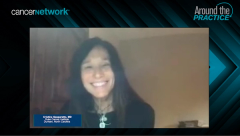
Treatment Options for First-Line Therapy in Transplant-Ineligible MM
In-depth considerations for available frontline therapy regimens for patients with transplant-ineligible multiple myeloma.
Episodes in this series

Transcript:
C. Ola Landgren, MD, PhD: Now, we have a new polling question. Question No. 5: Recognizing that there are other options, which of the following induction regimens would you be most likely to use as the first-line therapy in a standard-risk patient? This is, again, nontransplant candidates. Is it VRd [bortezomib, lenalidomide, and dexamethasone], DRd [daratumumab, lenalidomide, and dexamethasone], Dara-VRd [daratumumab plus VRd], KRd [carfilzomib, lenalidomide, and dexamethasone], or other? Please go ahead and vote. VRd and DRd are the 2 winners here, based on small numbers. What is the main reason for your choice, in this previous question? The options we have here are comfort level/experience with the regimen, patient preference, overall survival data, other efficacy data, quality of life, safety and tolerability, or other reasons. There was only 1 winner here, and that’s C. That’s the overall survival data. Let’s turn back to the panel then. What are the treatment options for this first-line therapy in the transplant-ineligible patients that you would use in your clinic, Craig?
Craig Hofmeister, MD, MPH: I think in our group, we have the most spirited discussion about this, but we have the most spirited discussion before the question. Because we argue incessantly about who is high risk, who’s intermediate risk, who’s standard risk. I think, if you’re willing to accept standard risk is this vague thing that breeds consensus, then I think that many of us are quite happy with the data from the MAIA study, and doing daratumumab, lenalidomide, and dexamethasone is very appealing in the standard-risk patients. But within my group, how we define standard risk, and intermediate and high risk seems to change on a week-by-week or sometimes day-by-day basis. Thus, that’s where things are in Atlanta.
C. Ola Landgren, MD, PhD: I was teasing with Cristina before when I asked her if there are any transplant-ineligible patients. So because you bring it up, I ask you Craig, are there any patients with non–high-risk myeloma?
Craig Hofmeister, MD, MPH: I would say that there are lots of patients with non–high-risk myeloma. I think that the question that we often struggle with is, who’s really the standard risk and who’s an intermediate risk? And do you even allow an immediate-risk category? I think that’s where we spend all our time arguing. I think we spend much less time arguing about what to do than which bucket to put them [patients] in.
C. Ola Landgren, MD, PhD: Peter, I will ask you a follow-up to what Craig is bringing up here. The standard risk and high risk or intermediate risk, or whatever risk. I also saw in the most recent NCCN [National Comprehensive Cancer Network] guideline document, one of the regimens had a star, where it said that it was reserved in particular for patients with aggressive myeloma. What is that?
Peter Voorhees, MD: Well, high-risk myeloma is certainly more likely to be aggressive. But I think when people talk about aggressive, they kind of talk more about the kinetics and the level of symptom burden and tumor burden that the patient is experiencing. But as far as high-risk disease, I think all of us would agree that the patients with deletion 17p are high risk. Concerning the high-risk IgH [immunoglobulin heavy-chain] translocations, you can argue about the 4;14 translocation and whether that should be considered an intermediate risk in the age of proteasome inhibition. There’s now the emerging story of gain 1q21. Are 3 copies really high risk, or do you have to have 4 or more? I think the more copies you have, the worse you do. Amp [amplification of] 1q21 is definitely a high-risk feature in my book. I think an elevated LDH [lactate dehydrogenase] is a good indicator of aggressive highly proliferative disease, and extramedullary disease, or 5% or more plasma cells in the circulation, all of those I would consider high risk.
C. Ola Landgren, MD, PhD: What about the patient who is 17p deleted, and then someone has ordered a next-generation sequencing assay, and it turns out that it’s only for 1 of the 2 alleles, so there’s no mutation on the other allele. Is that high risk?
Peter Voorhees, MD: No, that’s an excellent point. They’ve knocked out 1 copy of TP53 cytogenetically and the other copy’s intact, so that is not a high-risk feature based on the data that exist. My feeling is that those patients who have 1 remaining good copy are at higher risk of eventually losing that copy and a subclone with a subsequent mutation, so I certainly don’t want to ignore that deletion 17p, but I would think that they’re more of an intermediate-risk group. Unfortunately, with standard commercially available testing, we don’t typically sort that out.
C. Ola Landgren, MD, PhD: I think there was a paper in the Leukemia journal in 2019 by Brian Walker, [MD,] as the first author, that showed that patients who have 17p deletion, the ones who have a mutation on the other allele, the biallelic inactivation similar to double-hit lymphoma and the same equivalent of, that they had a significantly worse both PFS [progression-free survival] and OS [overall survival]. But he had in his study showing the monoallelic-only 17p, or the ones who don’t have 17p but they have a mutation, those we wouldn’t see with FISH [fluorescence in situ hybridization], that they have the same outcome as people without the monoallelic. That was based on his study, so I think the jury is maybe is still out a little bit, and we would not test for this typically. There was no standard test. But I think if we use sequencing-based technology, this information could be revealed for every patient, but we don’t have that yet as standard of care, right?
Peter Voorhees, MD: Yes, and I’ve got plenty of patients with deletion 17p who’ve defied all odds, who are many years beyond initial treatment. They’re on maintenance therapy, and they are in MRD [minimal residual disease]-negative CRs [complete remissions], and I am certain that they are just one-hit patients.
C. Ola Landgren, MD, PhD: What are the preferred regimens in this very setting for the transplant-ineligible patient per the NCCN guideline? I believe the VRd is there, that Dara-Rd is there, and also Rd I think is listed, or is that listed as an alternative therapy? For sure, we would consider for some frail patients maybe a 2-drug combination, then if we have to cut back could we do RVd-lite?
Cristina Gasparetto, MD: Correct.
C. Ola Landgren, MD, PhD: What do you think about for a frontline regimen to use in a newly diagnosed transplant-ineligible patient? What are the considerations, and how would you weigh them? Does the choice of initial therapy impact the options and choices for maintenance and later therapies? Or if you gave more drugs up front, would that impact how you would do maintenance later? Let’s say you gave a 3-drug combination up front, would you think of putting this patient on a single-drug maintenance, versus if you do 2 drugs? Would you keep that patient on 2 drugs continuously? Cristina, do you have some thoughts about that?
Cristina Gasparetto, MD: Yes. Of course, I always think about it, and unfortunately, you have to learn to individualize because you can’t just apply something for all patients. One thing that I always think about is if you look at the overall survival of the older patient, it’s inferior compared to the younger patient. But there is nothing different in the biology of the disease; it is how we treat them. We tend to treat them suboptimally because they’re older and they have compromised organs, renal, and so we make a lot of adjustments. It is clear from all the data that we are accumulating that going strong even in this population is very important. Three drugs are better than 2, and we have some phenomenal data now generated in the triplet combination in this population of patients. Three drugs, and then what’s happening, I think maybe we don’t do the bone marrow all the time. We don’t chase the MRD, but I think that based on the response, if I have a patient on 3 drugs achieving a VGPR [very good partial response] and I still detect myeloma there by blood, I would probably keep a little bit more aggressive continuation of therapy versus the patient achieving the complete remission. I would feel more comfortable to go to the single agent, so I individualize, and I try to achieve the same goal that I try to achieve with the younger population of patients. We see that with the DRd, the MAIA study clearly, a better MRD, complete remission, overall response translating into a longer PFS and survival.
Transcript edited for clarity.
Newsletter
Stay up to date on recent advances in the multidisciplinary approach to cancer.










